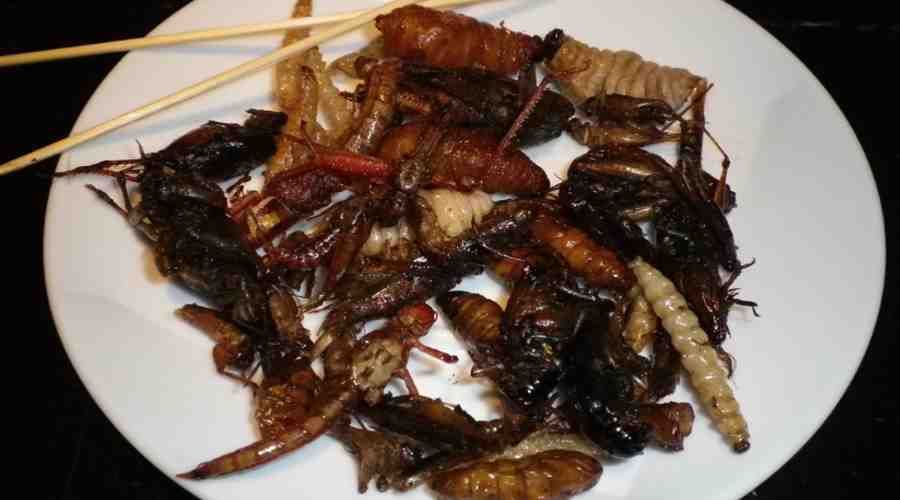
Chocolate-covered cockroach, roasted larvae, coated locusts. Insects are a good source of food
Chocolate-covered cockroach, roasted maggots, breaded locusts. Insects are a good source of food?
Before eating insects will be our daily bread, scientists need to find out whether ants, locusts and cockroaches are a good food source. It is necessary to study what nutrients they have, how these nutrients are assimilated by our body and which beetles are the most caloric. Such research is being conducted by Dr. Ing. Anna Zolnierczyk of Wrocław University of Life Sciences.
On how the insects she tested taste, the researcher m i in an interview with PAP. – On the og ³ insects are roasted or fried. also those served sweet, in chocolate; we, for example, made a brownie with woodchucks. Mr ki have a sour aftertaste and are por nn to citrus. Insect larvae such as mealworms contain a lot of fat, so they have a nutty aftertaste, as does cold-pressed canola oil. Crickets, if eaten whole, resemble well-fried meat. Locusts are best in a batter coating. Silkworms are a rich source of dłem micronutrient – the researcher praises. And the cockroaches? It’s the future of the Wroclaw breeding. There has been no official tasting yet, but researchers predict that cockroaches, like shrimp, will be extracted from chitinous carapaces and consumed warm.
Dr. Zolnierczyk is the supervisor of the student Scientific Circle of Molecular Cuisine. Previously, she and her charges participated in the Food Think Tank educational projects. The project is supported by Also the consortium Wroclaw Biotechnology Center formed by eight entities , including three departments of the Wroclaw University of Life Sciences. The consortium has been awarded the status of National Scientific Leading Center (KNOW) in the field of agricultural sciences.
– At the beginning we bought beetle larvae – whitefly, woodlice and two species of locusts: desert and migratory. We are a food science department and are interested in finding out whether insects have adequate nutritional value. Insects are considered a low-calorie source of s protein pits. If the leek namy beef steak and cricket steak, the former hypertrophied with fat tastes much better. On the other hand, in "meat" The insect is much more protein relative to fat, especially lnie in insects in adults. Therefore, they can be considered low-calorie or dietary. There are studies on the caloricity of insects and the protein content of the food prepared from them – explains Dr. Zolnierczyk.
In order to obtain complete nutritional information, the researchers began their study with an acid profile in fatty. Vegetable fat is better than animal fat, but it is important that they are unsaturated fatty acids. nie important in our diet are sterols – not only cholesterol, but also phytosterols. So the sterol profile and elemental composition of the insect were studied – calcium, iron, magnesium, s d, potassium, as well as heavy metals.
Insects land on plates in 80 percent of the. country of the world
Part of the research concerns the bioavailability of metals. As rozm explains PAP’s author, some re metals are better absorbed if they come from product in animals, in the por In comparison with those that re come from plants. For example, iron is better absorbed from a product of a In animals as heme iron.
– Insects are eaten in 80 percent. country in the world – either as a supplement or a permanent part of the diet. Western civilization, especially Europe, puts op this habit. To us insects are associated with dirt, we do not even want to imagine that they end up in our mouths, we feel disgusted. And yet we eat shrimp, which re have appeared on our tables and are a delicacy. If you look at a shrimp and a cockroach, there is no huge between them The filament – m i researcher.
And how does the fact that we consider bugs dirty relate to this? According to Dr. Zolnierczyk, no dirtier than other products, which re we consume. Yes, insects also often have parasites, bacteria, but after all, an insect intended for consumption we do not catch in the meadow. It is important to grow them in controlled conditions to avoid microbial infections. Before serving the insects always have to be subjected to the processing thermal treatment.
– Certainly, each of us takes in toxins from the environment. If we want to raise beef for ourselves, we must have a large field, pasture, adequate housing. Insects are easy to grow, in which case sterile boxes can be stacked on shelves in one average room. The culture can be maintained under proper conditions, without access to harmful compounds from the environment, that is, without heavy metals or contaminated water – m i researcher.
Home breeding of insects ?
He adds that control is easy, and large amounts of biomass are quickly obtained. There are even home devices for growing insects in which rych are placed leftovers from the table and from the kitchen. They resemble sprout culture devices. This is done in Asian countries, where insect protein is a prized culinary addition.
Scientists have already studied two types of beetle and locust larvae, and are now beginning to study cockroaches. Pr They are also trying to create functional foods. This involves feeding the insects in such a way b so that there are more nutrients and compounds in their bodies in biologically active. Some re biologically active compounds should be in our diet, but are poorly absorbed by us. Everything can change if these valuable ingredients are preliminarily „overworked” by insects. Perhaps the insect, as a result of its metabolism, can convert them into such compounds, which re will be soluble in water, and will not lose their properties. W hen we eat such an insect, along with it we provide ourselves with a more easily digestible compound.
Cheap sources of food source
Dr. Zolnierczyk emphasizes the economic value of insect cooking. Insects are a cheap source of food source. From the same amount of food you can grow about 9 times more crickets than beef. He reminds us that cows are warm-blooded and need a lot of energy from food to maintain the process in vital signs and body temperature. Insects convert most of what they eat into biomass.
– From the insect In more can be eaten, and some re even eaten whole. From a cow, we throw away as much as 60 percent of. – is sk ra, bones, hooves, horns. In the case of all insects In garbage, on average, only 20 percent. – m i doc.
Another aspect is ecology. Breeding insect means much less water consumption than raising other animals that provide us with protein. From the same amount of water, you can grow 12 times more insect mass than beef mass. Transporting and raising beef involves the emission of gas in the greenhouse, with ammonia contamination, acid rain and environmental degradation.
– We approach everything new with a lot of uncertainty. When sushi entered our market, we felt op against eating raw fish. Today it is an exclusive dish. Maybe in a few years or so we will have to eat insect protein. Before doing so, it’s a good idea to get everything right,” concludes Dr. Zolnierczyk, and reminds us that we eat bugs anyway. This happens in our sleep, when we are running or cycling. We eat them unknowingly in fruit and vegetable preparations and then when we eat cherries, plums, apples and pears. Whole mn stwo worm we absorb along with dried mushrooms for sale. Statistically, we eat about p ł kilogram per year.
Source Source: PAP – Science in Poland, Karolina Duszczyk, fot. maxpixel

